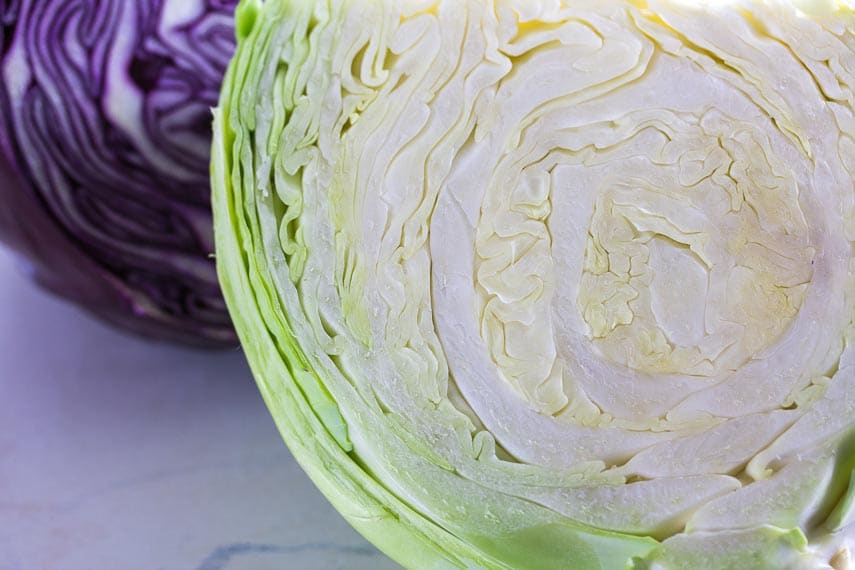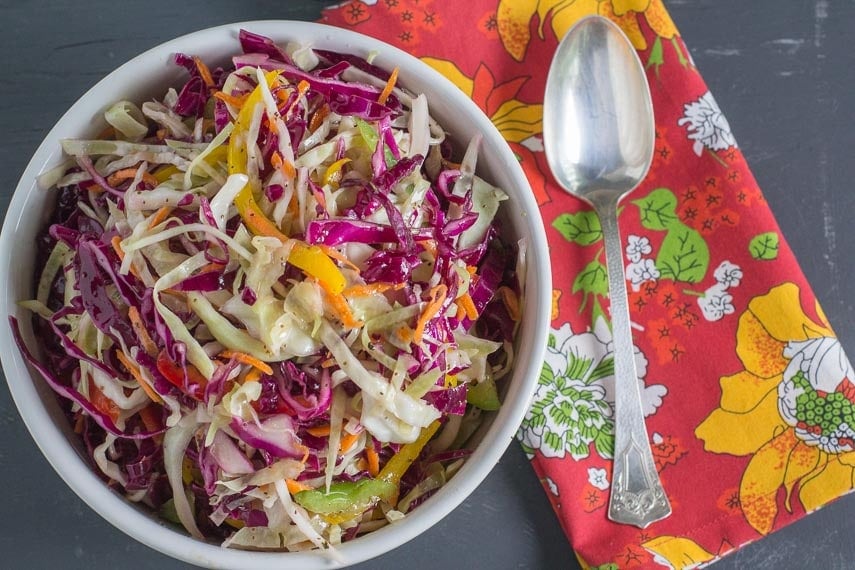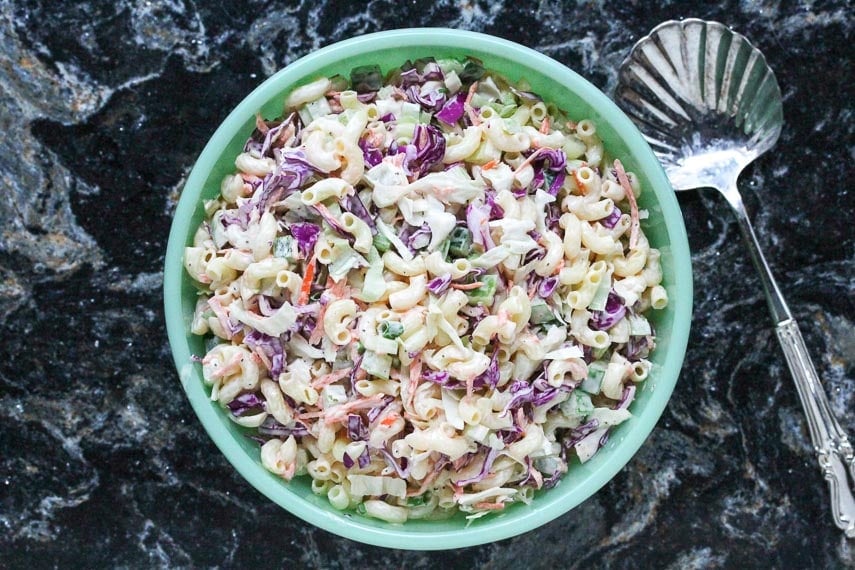All About Cabbage & FODMAPs – Green, Red, Savoy & Napa
NOTE: This information was updated October 2024.
You Can Eat Cabbage! This Explore An Ingredient will tell you everything you need to know about cabbage & FODMAPs.
Several types of cabbage are listed on the Monash smartphone app and the FODMAP Friendly smartphone app and have been lab tested for FODMAPs – and we will discuss them all here.
Many Kinds of Cabbage Have Low FODMAP Serving Sizes
We will cover:
- Green Cabbage (Brassica oleracea)
- Red Cabbage (Brassica oleracea)
- Savoy Cabbage (Brassica oleracea)
- Napa Cabbage (Wombok/Chinese Cabbage [Brassica rapa])

For Bok Choy, please see that entry in Explore An Ingredient: Bok Choy.
Versatile Cabbage
Cabbage are versatile vegetables and can be eaten raw or cooked, in slaws, salads, stir-fries, soups, braises and in so many other ways – including sauerkraut and other fermented preparations, and of course corned beef and cabbage, for which we have a low FODMAP recipe.
We will take these cabbages one by one with links to recipes at the end of the article.
Types of Cabbage
Green, red, Savoy and Napa cabbage are part of the Brassica family. While there are low FODMAP serving sizes of these vegetables, they can create gas in many individuals, so your individual tolerance is very important to pay attention to, regardless of FODMAPs.
It might be helpful to review our article, What Is A Low FODMAP Serving Size?
Green Cabbage
Also called “common” cabbage by both Monash and FODMAP Friendly, and sometimes referred to as white cabbage.
- Monash lists this cabbage as low FODMAP in amounts of 75 g (¾ cup).
- FODMAP Friendly lab tests show low FODMAP servings also at 75 g (¾ cup). A prior test placed the max low FODMAP serving at 175 g (1 ¾ cups), which has been updated to 125 g.

It is important to note that FODMAP Friendly lab tests for Green Cabbage showed Sorbitol, which is not the same FODMAP as other cabbages. Monash testing shows fructans.
Red Cabbage
Also sometimes referred to as “purple” cabbage, it is indeed more purple than red, and it loses much of its color when cooked, often turning very pale, and even a tad grey, so be forewarned.

Red cabbage has been shown to contain fructans.
- Monash lists red cabbage as low FODMAP in amounts of 75 g (¾ cup).
- FODMAP Friendly lab tests show low FODMAP servings of 100 g (1 cup chopped); initial max low FODMAP serving was 200 g (2 cups chopped), updated to be 167 g.
Savoy Cabbage
Savoy cabbage can easily be confused with common green cabbage at first glance, but if you take a look you can see the somewhat frilly texture of its leaves, which distinguishes it from green cabbage visually.

Flavor-wise, Savoy is similar to green cabbage but many consider it to be a sweeter, milder taste. Monash lab tests have shown fructan content. FODMAP Friendly lab testing has shown very small amounts of fructans and GOS.
- Monash lists Savoy cabbage as low FODMAP in amounts of 40 g (1/2cup).
- FODMAP Friendly lab tests show low FODMAP servings of 75 g (1 cup chopped); initial max low FODMAP serving was 1575 g (21 cups chopped), updated to 1500 g.

Above in the image the pile of Savoy equals the low FODMAP ½ cup (40 g), which is actually a decent amount, whether incorporated in a slaw or a cooked dish.
Napa/Chinese Cabbage/Wombok
- According to Monash University, Chinese cabbage is low FODMAP in amounts of 75 g (1 cup) and contains Fructans in Moderate servings of 500 g (6 2/3 cups)!!! (Updated to 488 g/6 ½ cups).
Note that they used to call it Napa in the app.
- FODMAP Friendly calls it Chinese cabbage and they put a low FODMAP serving at 75 g (1 cup chopped), with a max serve at 1575 g (21 cups), updated to 1500 g.

Napa Cabbage is mild in flavor and often used in stir-fries and soups and can be enjoyed in kimchi, in small amounts (made with low FODMAP ingredients).

Lab Test Discrepancies
The fact that the Monash lab tests and the FODMAP Friendly lab tests do not agree is not a problem.
Please read our articles, When Low FODMAP Lab Test Results Differ, and also, FODMAP Content In Food Is Variable.
The app entries are meant to be used as GUIDES. The cabbage you buy cannot be the same as the cabbage that was tested. The articles explain thoroughly.
How To Buy
Cabbages are typically available year-round but will be best during the cooler autumn and winter months.
All cabbages should be heavy for their size and have tight leaves, except for perhaps a very few loose outer leaves. The leaves should have no discoloration, although if a small amount is present and it is isolated to a leaf or two, it can be dealt with during prep, as described below.
In fact, if you are buying from a farmers market and the cabbage is super fresh, it might have some very loose, tough outer leaves that are very much apart from the head, and that’s okay. You can see the red cabbage in our FODMAP Everyday®garden, below.

Inspect the stem end and make sure it is not cracked or overly dry, which would indicate long storage.
Napa should show very crisp, plump looking leaves, especially the whiter part towards the stem end.
Green cabbage, when stored for a very long time, can look almost white, so this can be an additional indicator of freshness.
Use That Scale
A little goes a long way, so try to buy the size cabbage that most closely matches your needs.
How To Store
Keep cabbages refrigerated until needed. Green and red cabbage can often be refrigerated for up to 2 weeks. Napa and Savoy are less hardy and should be used within the week.
Once cut, refrigerate halves, quarters or shreds covered well, either with plastic wrap or in zip-top plastic bags.
How To Prep
If there are a few very loose outer leaves, simply peel or cut away and discard. Then, if the outer leaves that are tightly wound around the cabbage are less than attractive, plump, flexible and moist or if they show any discoloration, you can discard those as well, or very often, simply cut away and discard any parts that are discolor.
Washing Cabbage
Some instructions will be to rinse and either shake or spin-dry cabbage or pat large leaves dry. We often just give the outer head a quick rinse and pat down until dry before cutting.
Cutting Cabbage
Cut the cabbage in half, top to bottom, exposing two halves showing the hard inner core. Cut in half again, bisecting the core. Make a triangular cut into the quarters to cut away the root end and hard core, which you discard.
Many recipes such as coleslaw and other salads require the cabbage to be cut into thin, ribbon-like pieces. After coring, cut across the head into ¼-inch (6 mm) wide strips. The shreds will be long and flexible. If they are too long, you can halve them.
A mandoline can work too for green or red cabbage and sometimes Savoy if it is very fresh.
Some folks shred red and green cabbage with a box grater or with a food processor, but I find the cabbage pieces end up too small and much of its slightly chewy yet crunchy texture is lost and the visual suffers, as well.
How To Cook & Prepare
It all depends on the recipe, but one thing to make note of is that many folks think they do not like cabbage because they have only had very over-cooked cabbage.
Those same folks very often like coleslaw, so it isn’t cabbage per se that they have issues with. Also, some people find they can digest raw cabbage better than raw, or vice versa, and this can be highly individual.
For recipes, such as slaws and coleslaw, you will using the cabbage raw.
For stir-fries, the cabbage will be very briefly cooked just until crisp-tender.
For stuffed cabbage recipes, it is cooked until tender. And for dishes such as a New England boiled dinner or Corned Beef and Cabbage, there will be more extended cooking time.
Cabbage can give off quite a pungent smell when cooked, and that can be offensive to some, but the result can be a silky, almost melting quality to the vegetable, so there is a benefit to look forward to at the end.
Kimchi, which is a very popular condiment, is prepared by salting cabbage, usually Napa, and then combining with a spice mixture all of which is then left to ferment.
Here are some fabulous recipes featuring cabbage:

- Corned Beef & Cabbage
- Slow Cooker Corned Beef & Cabbage
- Tofu with Bok Choy
- Creamy Coleslaw with Raisins



Notes on Fermented Cabbage
We have done quite a bit of research on fermented cabbage and have some interesting findings.
Monash has lab tested fermented red cabbage and fermented white cabbage, aka sauerkraut. We asked them for some clarification and it turns out that the products were pasteurized. This could be significant, as we will explain.
According to Monash, pasteurized fermented red cabbage is Green Light Low FODMAP in ½ cup (75 g) portions. At 1 cup (140 g) it becomes Moderate for fructans (updated to 2/3 cup/130 g).
The Monash app lists pasteurized fermented white cabbage, sauerkraut, as Green Light Low FODMAP. Initially the lab tests resulted in suggesting 1 tablespoon (20 g) servings, and stated that it becomes Moderate for mannitol at 1 ½ tablespoons (30 g) and High for mannitol at ½ cup (75 g). Currently the app says low FODMAP is 2 tablespoons (23 g), Moderate is ¼ cup (35 g) and high is ½ cup (75 g).
Fermentation is a living process and it is not surprising at all that there would be different results upon re-testing. As always, use the app as a guide.

We have discussed cabbage fermentation extensively in our article, Is Kimchi Low FODMAP? and our recipe Low FODMAP Kimchi ? and we encourage you to read them.
The short story is that mannitol is considered an “intermediary” sugar in the fermentation process. If fermented cabbage is allowed to continue to ferment, mannitol disappears.
Pasteurization halts the fermentation process. Monash tested pasteurized products and if the fermentation was at the point where mannitol was present, then the lab tests might very well have shown mannitol, which is what their tests have shown.
Our supposition is that a raw, live sauerkraut, that has a long fermentation might very well not be moderate or high for mannitol and might be able to be consumed in larger quantities and still be low FODMAP. This is an educated guess, but we find it interesting nonetheless.
As always, how you digest an untested food is what is most important. Please read our article, What If A Food Has Not Been Lab Tested For FODMAPs?

